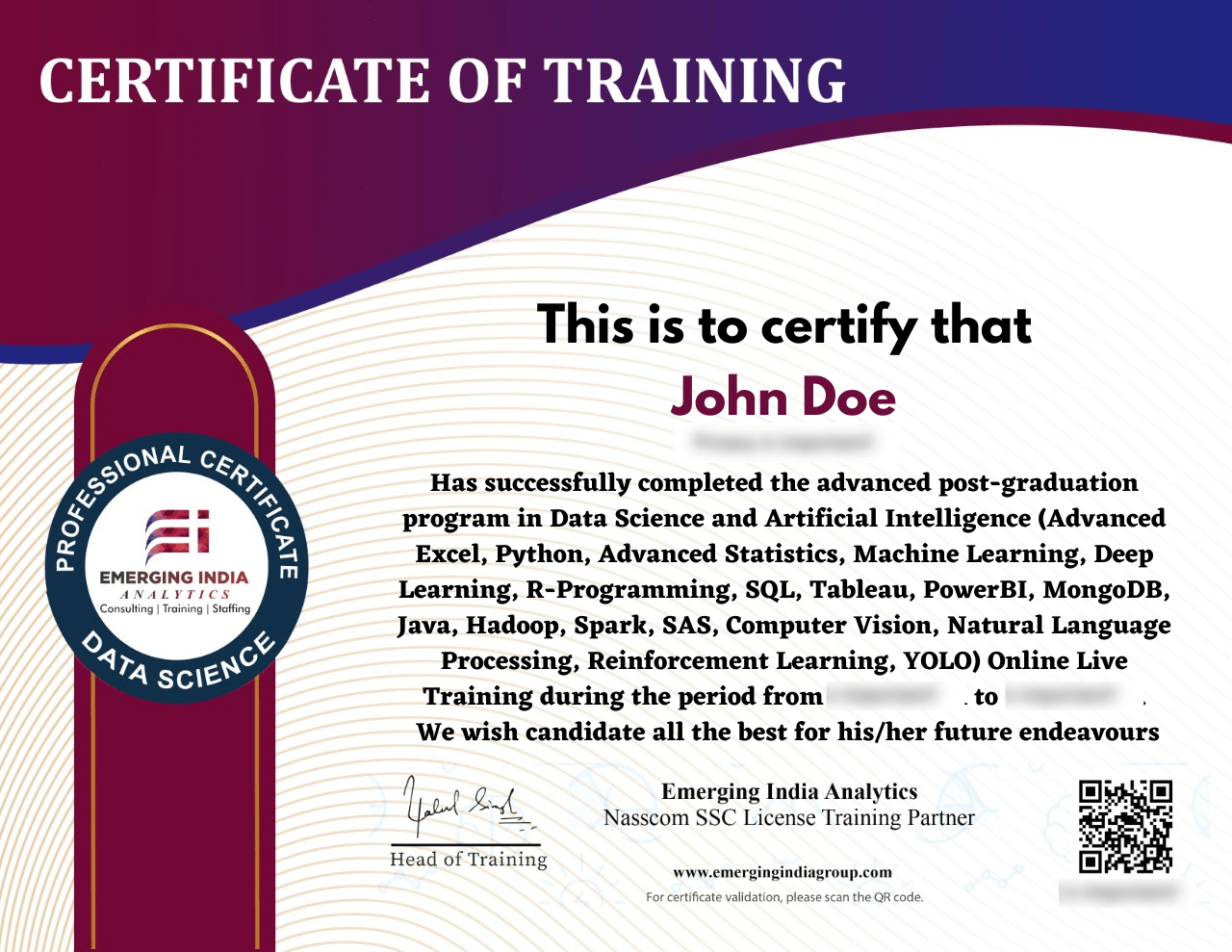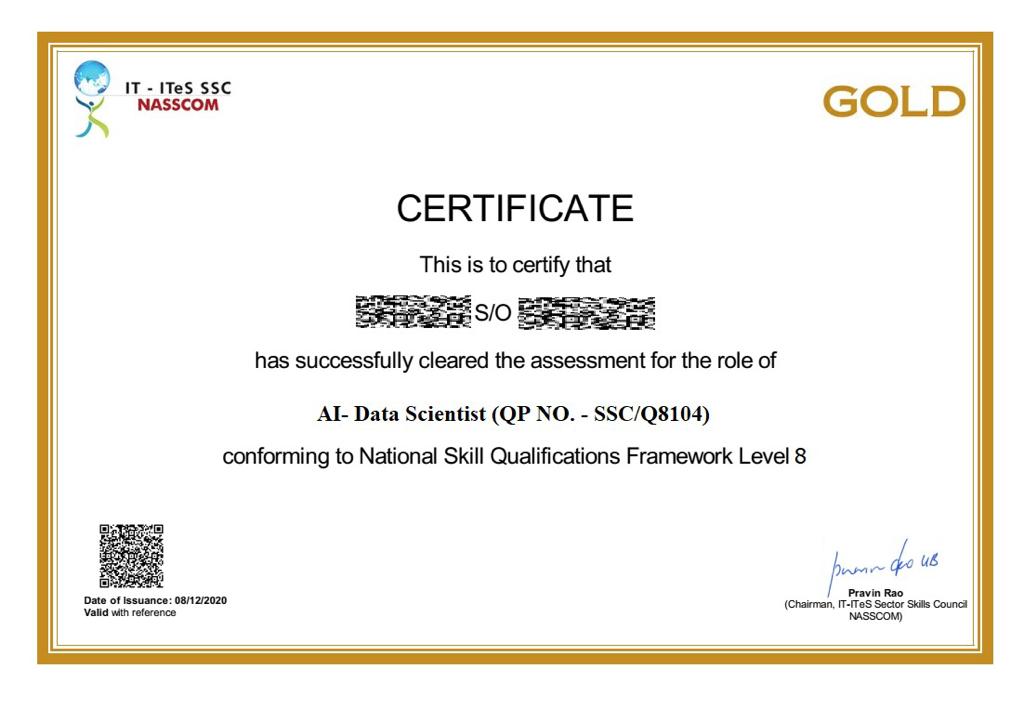Features
- Lectures - 120
- Duration - 60 Weeks
- Case Studies and Assessment - 35+
- Delivery Mode - Online
- Batches - Weekend
- Capstone Projects - 25+ projects (Choose anyone)
Data Science is a cross-disciplinary blend of tools and technologies that work conjointly to understand business, clients, and patterns and resolve inquisitions that we yet not perceive from the data stored in data warehouses and all possible web applications. This program is the perfect blend of Statistics, Programming, Machine learning, Deep Learning, Artificial Intelligence, Data Visualization, and big data designed to give you a holistic view of Data Science.
Program Overview
- The most comprehensive curriculum with training material designed by NASSCOM, along with its 35 SIG(Special Interest Group) members such as Goldman Sachs, IBM, Ins Analytics, Infosys BPO, Insights of Data, JP Morgan, Karvy Analytics, Knod Global, KPMG, Wipro, WNS, Wells Fargo, Amazon, Capgemini, Concentrix, CITI, Cyient Insights, Accenture, EXL, First America, Fractal Analytics, GENPACT, Google, ADP Deloitte, HCL, HDFC, IBM, ISC2, NIIT University, PwC, Symantec, TCS to name a few, that will prepare you for future externalities in the data analytics industry and fulfill the gap of academics and industry requirements.
This official NASSCOM-CERTIFIED Data Science Program covers R, Python training, and Data Wrangling. - Interaction with Big Data Hadoop, MapReduce, Sqoop, Flume, Hive, Pig, HBase, Spark, R with Statistics, Data Mining, Machine Learning Algorithms, Deep Learning, Natural Language Processing, Computer Vision, Reinforcement Learning, Time-Series forecasting, SQL, Tableau and SAS.
Program Structure
- 70-Hour Pre-Learning: Before you come in, get ready for the Program. You will get a series of online recorded tutorials to understand the nitty-gritty of Data Science, Artificial Intelligence, Visualization tools, and data structure.
- 360 Hours Program: Here, you will get Hands-on Experience in advanced Excel, SQL, R Programming, Python Programming, Statistics, Machine Learning, Artificial Intelligence, Big Data, Tableau, Power BI, MongoDB, YOLOv5, Natural Language Processing, Reinforcement Learning.
- 560 hours Post Program: Learning does not stop here. After completing the Program, you will work on Projects, Tests, and Assignments. Doubt-clearing sessions will also be provided. You will be working on capstone projects from a long list projects.
Eligibility:
- Work Exp– Working professionals in IT / Analytics / Statistics / Big Data / Machine Learning.
- Education – Bachelor’s Degree in Engineering / Technology / Statistics /
Mathematics / Computer Science

Sample Certificate

Nasscom Certificate –

-
Advance Excel
Microsoft Excel Overview, Formatting Excel Shortcuts Basic Formulas, Sorting Data, Filtering Data, Column Chart Pie Chart, Pivot Tables, Vlookup, Match Function, Lookup Function, VBA
-
Python Programming
Introduction To Python, What and Why Python, Variables, Databases and various Operation, Datatypes and various Operations, Operators, Block Structure, Data Structures, Functions, Modules, Class, Numpy, Pandas, Matplotlib, Seaborn
-
Advance Statistics
Introduction To Statistics, Descriptive Statis [], Population And Sample, Types Of Data, Percentile, Quartile, IQR, , Measure Of Central Tendency, Asymmetry And Variability , Skewness, Kurtosis, Central Limit Theorem, Confidence Interval, Probability, Probability distribution, Discrete Probability Distribution [Probability Mass Function, Binomial Distribution, Poisson Distribution, Discrete Uniform Distribution],Continuous Probability Distribution [ Probability Density Function, Normal Distribution, Continuous Uniform, Exponential Distribution], Hypothesis Testing [Z Distribution, Student’s T distribution, Chi Square , Chi-Square goodness of fit, Chi square test of independence, Bayes Theorem, Correlation[ Pearson Corelation, Linear Corelation], Covariance
-
Machine Learning
otIntroduction To Machine Learning, Types of Machine Learning, Linear Regression, Logistic Regression, Decision Trees, Naive Bayes, K-Nearest Neighbor, Support Vector Machine, Random Forest, Cross Validation [K-fold cross-validation, Hold-out cross-validation, Stratified k-fold cross-validation], Hyperparameter Tuning, Ensemble Learning [ Lasso Regression, Ridge Regression, Adaboost, Adagrad, PCA, K-Means,
-
Deep learning
otIntroduction To Neural Network, Foreword Propagation, Activation Function, Optimizers[SGD, RMSProp, Adam, Adadelta, Adamax, Adagrad, Adam], Activation Function [ Linear, Sigmoid, Tanh, ReLu, Leaky ReLu, ELU, Softmax, Swish], Loss Classification(BinaryCrossentropy, CategoricalCrossentropy, SparseCategoricalCrossentropy, Poisson, binary_crossentrop, categorical_crossentropy function, sparse_categorical_crossentropy function, Regression (MeanSquaredError class, MeanAbsoluteError class, MeanAbsolutePercentageError class, MeanSquaredLogarithmicError class, CosineSimilarity class)], Weight Initialization [ Xavier Weight Initialization, Normalized Xavier Weight Initialization, He weight Initialization], Bias Initialization, Callbacks [ReduceLROnPlateau, ModelCheckpoint, Earlystopping], TensorBoard, Keras Tuner, Padding, Pooling, Convolution, , Time Series Analysis ,Component of TSA, Methods to check stationarity [ADF , KPSS], AR, Moving Average Methods [Simple Moving Average , Cumulative Moving Average, Exponential Moving Average ] ACF, PACF, ARMA, LSTM, GRU
-
R Programming
What Is R Programming, Variables And Data Type In R, Logical Operators,Vectors,List,Matrix,Data Frame,Flow Control, Functions In R, Data Manipulation In R- Dplyr, Data Manipulation In R- Tidyr, Data Visualization In R
-
SQL
BASIC OF DATABASE, TYPES OF DATA BASE, DATA TYPES, SQL OPERATORS, EXPRESSION (BOOLEAN, DATE, NUMERIC), CREATE, INSERT, DROP, TRUNCATE, DELETE, ALTER, UPDATE, SELECT, RANGE OPERATER, IN, WILDCARD, LIKE CLAUSE, CONSTRAINT, AGGREGATION FUNCTION, GROUP BY, ORDER BY, HAVING, JOINS, CASE, COMPLEX QUERIES, Trigger, Stored Procedures, Common Table Expression, Index, Except, Exists, Grouping set, Pivot, Rollup, Cube, Constraints, Partition
-
Tableau
TABLEAU PRODUCTS, INSTALLATION OF TABLEAU DESKTOP/PUBLIC, CONNECTING TO DATABASES, REPLACING DATASOURCE, TABLEAU CANVAS INTERFACE, DATA TYPES, DRILL DOWN, HIREARCHIES, MEASURES, DIMESIONS, SORTING, GROUPING, PARAMETER, SETS, COMBINE, DATA BLENDING, FILTER, MARKS CARD, DUAL AXIS, CALCULATED FIELD, VISUALZATION, CANVAS FORMATING, DASHBOARD CREATION, Pareto Analysis, Table calculation, Multiple data source blending, Advanced charting techniques, Tableau prep tool
-
PowerBI
POWER BI PLATFORM, PROCESS FLOW, FEATURES, DATASET, BINS, PIVOTING, QUERY GROUP, DAX FUNCTION, FORMULA, CHARTS, REPORTS, DASHBOARDS, Multiple data source blending, Basic of SSIS for ETL
-
Big Data Analytics with Hadoop and Spark
- Java (Installation, Syntax main()/printIn()/print(), Variable [String, Int, Boolean, float, char], Datatypes, Operators, conditions, loop, methods, class, file handling)
- MongoDB (Introduction, Installation, Data Modelling, Database operation, Collection, Data types, Insert, Query, Update, Delete, Find, Limit, Skip, Create Index, ObjectID, Aggregate, Replication, Shrading, Dumping and Restore, Mongostat and Mongotop, MongoDB client setup using Java, Reference and Embedded Relationship, DbRefs, Cover Query, $explain, $hint, findAndModify, Indexing Array and subfield, MapReduce, Text Search, Index, RegeX)
- Hadoop (Introduction To Hadoop, Scaling (Horizontal And Vertical), Challenges In Scaling, Concept And Challenges In Parallel Computing, Distributed Computing And Use In Hadoop, Core Components Of Hadoop, Hadoop Working Principle, Hadoop Commands And Implementation)
- MapReduce (MapReduce, MapReduce Implementation, MapReduce Implementation)
- Pig (Introduction To Pig, Installation Of PIG, PIG Query)
- Hive (Introduction To Hive, Hive Installation, Hive Implementation, HIVE_SQL Operations)
- HBase (Introduction To Hbase, Installation Of Hbase, Hbase Query)
- Sqoop (Introduction To Sqoop , Installation Of Sqoop)
- Flume (Introduction To Flume, Installation Of Flume, Flume Queries)
- Oozie (Introduction To Oozie, Installation Of Oozie, Oozie Query)
- Scala (Introduction to Scala, Installation of Scala,)
- Spark (Introduction To Spark, Resilient Distributed Datasets (RDDs), Spark Components)
- PySpark (Introduction Of PySpark, Installation Of PySpark, Queries)
-
SAS
-
Artificial Intelligence with Natural Language Processing, Computer Vision and Reinforcement Learning
- Computer Vision (Introduction To Image Processing, Feature Detection, OpenCV, Convolution, Padding, Pooling & Its Mechanisms, Forward Propagation & Backward Propagation For CNN Architectures AlexNet, VGGNet, InseptionNet, ResNet, Transfer Learning)
- Natural Language Processing (Introduction To Text Mining, Text Processing Using Python, Introduction To NLTK, Tokenization, Stemming, Bag Of Words, Sentiment Analysis, Name- Entity Recognition, Text Segmentation, Text Mining, Text Classification, LDA, Speech Recognition, Transformer, Librosa)
- Reinforcement Learning (RL Framework, Component Of RL Framework, Examples Of Systems, Types Of RL Systems, Q-Learning)
- YOLO v5 (Introduction, YOLO Architecture, Working Methods, Application, Pre trained object detection, Custom trained object detection, Darknet preparation, Data collection, Image labelling, Sync, Compilation and testing)
-
Data Structure and Algorithms
- Introduction to Data Structure (What are Data Structures? , Types of Data Structures , Types of Algorithms)
- Recursion ( What is Recursion? , How Recursion works? , Recursive vs Iterative Solutions , When to use/avoid Recursion? , How to find Fibonacci numbers using Recursion?)
- Big O ( Analogy and Time Complexity, Big O, Big Theta and Big Omega, Space Complexity, Drop the Constants and the non-dominant terms, Add vs Multiply, measure the codes using Big O?, time complexity for Recursive calls?)
- Arrays ( Types of Arrays, Arrays in Memory, Operation on one dimensional and two-dimensional array, Time and Space complexity of one-dimensional Array and two-dimensional Array)
- Python ( What is a List, List Operations, Common List pitfalls and ways to avoid them, Time and Space Complexity of List)
- Tuples ( Tuple operation, Time and Space complexity of Tuples)
- Linked List ( Insertion in Singly Linked List in Memory, Insertion in Singly Linked List Algorithm, Insertion Method in Singly Linked List, Traversal of Singly Linked List, Search for a value in Single Linked List, Deletion of node from Singly Linked List, Deletion Method in Singly Linked List, Deletion of entire Singly Linked List, Time and Space Complexity of Singly Linked List)
- Queue ( Queue using Python List – no size limit, Queue using Python List – no size limit, operations (enqueue, dequeue, peek), Circular Queue – Python List, Circular Queue – Python List, Operations (enqueue, dequeue, peek), Queue – Linked List, Queue – Linked List, Operations (Create, Enqueue), Queue – Linked List, Operations (Dequeue(), isEmpty, Peek), Time and Space complexity of Queue using Linked List, List vs Linked List Implementation, Collections Module, Queue Module, Multiprocessing module)
- Tree / Binary Tree ( Binary Tree, Types of binary tree, Basic Operations on binary tree, Searching for a node in Binary Tree , Insertion , Deletion, Traversals with LinkedList and List, ( o PreOrder , o InOrder , o PostOrder , o LevelOrder ))
- Binary Heap ( Binary Heap Property, Heap Operations, Creation, Peek, Insertion , Extraction, Deletion , Time and space complexity of Binary Heap)
- Sort Algorithms ( What is Sorting?, Types of Sorting, Sorting Terminologies, Bubble Sort, Selection Sort, Insertion Sort, Bucket Sort, Merge Sort, Quick Sort, Heap Sort)
- Circular Singly Linked List ( Insertion in Circular Singly Linked List, Insertion Algorithm in Circular Singly Linked List, Insertion method in Circular Singly Linked List, Traversal of Circular Singly Linked List, Searching a node in Circular Singly Linked List, Deletion of a node from Circular Singly Linked List, Deletion Algorithm in Circular Singly Linked List, Method in Circular Singly Linked List, Deletion of entire Circular Singly Linked List, Time and Space Complexity of Circular Singly Linked List)
- Doubly Linked List ( Creation of Doubly Linked List, Insertion in Doubly Linked List, Insertion Algorithm in Doubly Linked List, Insertion Method in Doubly Linked List, Traversal of Doubly Linked List, Reverse Traversal of Doubly Linked List, Searching for a node in Doubly Linked List, Deletion of a node in Doubly Linked List, Deletion Algorithm in Doubly Linked List, Deletion Method in Doubly Linked List, Deletion of entire Doubly Linked List, Time and Space Complexity of Doubly Linked List)
- Dictionaries ( What is a Dictionary?, Dictionaries in memory, Dictionary Operations, Time and Space Complexity of a Dictionary)
- Circular Doubly Linked List ( Creation of Circular Doubly Linked List, Insertion in Circular Doubly Linked List, Insertion Algorithm in Circular Doubly Linked List, Insertion Method in Circular Doubly Linked List, Traversal of Circular Doubly Linked List, Reverse Traversal of Circular Doubly Linked List, Search for a node in Circular Doubly Linked List, Delete a node from Circular Doubly Linked List, Deletion Algorithm in Circular Doubly Linked List, Deletion Method in Circular Doubly Linked List, Entire Circular Doubly Linked List, Time and Space Complexity of Circular Doubly Linked List, Time Complexity of Linked List vs Arrays)
- Stack ( Stack Operations, Create Stack using List without size limit, Operations on Stack using List (push, pop, peek, isEmpty, ), Create Stack with limit (pop, push, peek, isFull, isEmpty, ), Create Stack using Linked List, Operation on Stack using Linked List (pop, push, peek, isEmpty, ), Time and Space Complexity of Stack using Linked List, When to use/avoid Stack)
- Binary Search Tree ( Binary Search Tree, Insert a node to BST, Traversal, Search , Delete , Delete entire BST)
- AVL Tree [Operations on AVL Trees]( Insertion , Left Left Condition, Left Right Condition, Right Right Condition, Right Left Condition, Deletion , Left Left Condition, Left Right Condition, Right Right Condition, Right Left Condition, Time and Space complexity of AVL Tree)
- Trie ( Introduction to Trie, Common Operations on Trie , Insert a string in Trie, Search for a string in Trie, Delete a string from Trie)
- Hashing ( What is Hashing? Why do we need it?, Hashing Terminology, Hash Functions, Collision Resolution Techniques, Hash Table is Full)
- Searching Algorithms ( Introduction to Searching Algorithms, Linear Search, Binary Search, Time Complexity of Binary Search)
- Greedy Algorithms ( Introduction, Greedy Algorithm, Activity Selection Problem, Coin Change Problem, Fractional Knapsack Problem)
- Divide and Conquer Algorithms ( Divide and Conquer Algorithm, Common Divide and Conquer algorithms, How to solve Fibonacci series using Divide and Conquer approach?, Number Factor, House Robber, Convert One String to another , Zero One Knapsack problem , Longest Common Sequence Problem, Longest Palindromic Subsequence , Minimum cost to reach the Last cell , Minimum Cost to reach the Last Cell in 2D array , Number of Ways to reach the Last Cell with given Cost)
- Graph Algorithms ( Graph Representation, Create a graph using Python, Graph traversal – BFS, BFS Traversal in Python, Graph Traversal – DFS, DFS Traversal in Python, BFS Traversal vs DFS Traversal, Topological Sort, Topological Sort Algorithm, Topological Sort in Python, Single Source Shortest Path Problem (SSSPP), BFS for Single Source Shortest Path Problem (SSSPP), BFS for Single Source Shortest Path Problem (SSSPP) in Python, Why does BFS not work with weighted Graphs?, Why does DFS not work for SSSP?, Dijkstra’s Algorithm for SSSP, Dijkstra’s Algorithm in Python, Dijkstra Algorithm with negative cycle, Bellman Ford Algorithm, Bellman Ford Algorithm with negative cycle, Why does Bellman Ford run V-1 times?, Bellman Ford in Python, BFS vs Dijkstra vs Bellman Ford, All pairs shortest path problem, Dry run for All pair shortest path, Floyd Warshall Algorithm, Why Floyd Warshall?, Floyd Warshall with negative cycle, Floyd Warshall in Python, BFS vs Dijkstra vs Bellman Ford vs Floyd Warshall, Minimum Spanning Tree, Disjoint Set, Disjoint Set in Python, Kruskal Algorithm, Kruskal Algorithm in Python, Prim’s Algorithm, Prim’s Algorithm in Python, Prim’s vs Kruskal)


